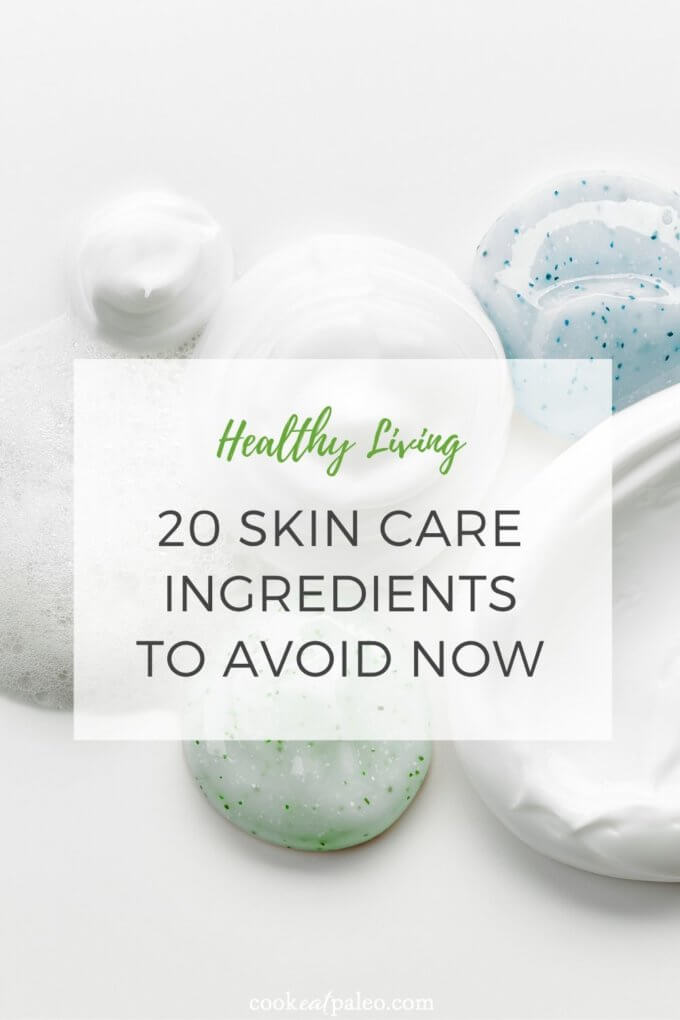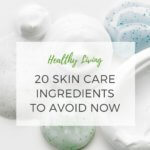You already know that living a healthy lifestyle includes more than clean eating and regular exercise. I firmly believe that you shouldn't have to play an ingredient guessing game every time you go to buy new skin care products. Here are the top 20 ingredients to avoid in skin care products, plus my favorite clean product shops.

Want to Save This Post?
Enter your email & I'll send it to your inbox. Plus, get great new recipes from me every week!
What's the biggest difference between people that feel confident in knowing they've made the healthiest decisions for themselves...and those who find themselves feeling completely overwhelmed at the thought of yet another ingredient decision?
I've been there too. But what I now know is that there's power in knowledge. You should feel confident knowing that you're taking care of yourself and your family, both inside and out, right?
Doesn't the FDA protect me from skin care ingredients I need to avoid?
Did you know that cosmetic ingredients – aside from color additives – do not require FDA approval before they go to market? Or that, in the eyes of the FDA, the term "cosmetic" wraps in items like nail polish, moisturizer, perfume, lipstick, makeup of all sorts, shampoo, perms, hair colors, and even deodorants?
Research has shown that the average adult uses 9 products like these every day, typically totaling up to 126 unique chemical ingredients. And (perhaps more alarmingly) that every day one in 13 women is exposing herself to ingredients that have also been identified as known or probable human carcinogens through those very same skin care products sitting on your bathroom shelf.
While there are certainly many skin care ingredients to avoid, shopping for safer skin care and makeup products can actually be easy. In fact, you don't need to DIY everything you use or give up all the luxurious bath products either!
Here's the truth about safer skin care:
When you know which skin care ingredients to avoid (and which clean beauty brands make safer products), buying healthy products is not only easy but fun!
This post contains affiliate links for your convenience. Please read my disclosure for more info.
Here are the top Ingredients to Avoid in Skin Care Products
1. Synthetic Fragrance
This term covers any and all engineered scent agents. These bad boys can contain any combination of 3,000+ stock chemical ingredients (including known allergens and identified hormone disruptors).
Unfortunately, fragrance formulas found in cosmetics are protected under U.S. regulations. Why? Because they remain classified as most likely to be a "trade secret." This classification allows them to remain undisclosed.
Found in: Practically all types of cosmetics (and other places in your home). If it says "fragrance" or "perfume" in the ingredient list it can contain any of these chemicals – including phthalates (see #2 below).
2. Phthalates
Phthalates like DBP, DEHP, and DEP are a class of plasticizing chemicals. They make the fragrances in your skin care products stick to your skin or make the product itself more pliable. There is plenty of research that indicates that this family of ingredients disrupts the endocrine system and is toxic to our organs (both reproductive and non-reproductive). They might also cause birth defects.
The European Union has already moved on banning this family of ingredients from use in cosmetics and skin care products, whereas the FDA continues to monitor its use. And while the FDA does require that manufacturers list this ingredient, there is a serious loophole in listing requirements. Why? This ingredient family is used in fragrances and fragrance ingredients are classified as "trade secrets", so you may also have products that contain one or more undisclosed types of phthalates.
Most commonly found in: synthetic fragrances (so basically most conventional products that are scented), soap, shampoo, deodorant, body lotion, nail polish, hairspray, aftershave lotion
3. Parabens
Parabens (including methylparaben, isobutylparaben, propylparaben, butylparaben, and others) are a family of preservatives that manufacturers use in skin care products to help prevent the growth of bacteria and mold.
There is strong evidence to indicate that this family of chemicals act as endocrine disruptors, meaning that they alter important hormone mechanisms in our bodies. There is also evidence to indicate that this class of ingredients is an allergen.
Most commonly found in: shampoo, face cleanser, body wash, body lotion, foundation.
4. PEG (Polyethylene Glycol)
This ingredient is widely used as a thickener and moisture-carrier in many skin care products. You might also find petroleum-based PEG compounds in your cosmetics as a solvent or softener.
The danger with this ingredient is that, depending on manufacturing processes, it could be contaminated with ethylene oxide and 1,4-dioxane, both of which have a robust body of data indicating that they are carcinogens.
Most commonly found in: creams, sunscreen, shampoo.
5. Retinol
Retinol is a synthetic form of Vitamin A. You'll find it in a variety of anti-aging skin care products, but "data from an FDA study indicate that retinoid ingredients may speed the development of skin tumors and lesions on sun-exposed skin" (EWG). At the very least, retinol is known to cause skin irritation, photosensitivity, and is not recommended for use during pregnancy or nursing.
Most commonly found in: moisturizers, anti-aging skincare products
6. Formaldehyde
There is significant data proving that this particular ingredient is, simply put, very bad. It could also be lurking inside your cosmetics as a preservative. Research shows that this is a known carcinogen. It's also linked to asthma, neurotoxicity, developmental toxicity and as a general irritant to skin, eyes, and lungs.
It's also a noted impurity in ingredients like quaternium-15, DMDM hydantoin, imidazolidinyl urea, diazolidinyl urea, sodium hydroxymethylglycinate, 2-bromo-2-nitropropane-1,3 diol (Bronopol), as well as several other preservatives that might be among the listed ingredients in your personal products.
Found in: shampoo, body wash, bubble bath
7. SLS (Sodium Lauryl Sulfate)
SLS is a foam booster and cleansing agent that can cause irritations for your skin, eyes, and lungs. It can also trigger allergies. There are also concerns of it causing non-reproductive organ toxicity as well as being an environmental toxin.
Most commonly found in: shampoo, body wash, bubble bath.
8. SLES (Sodium Laureth Sulfate)
SLES is used in a similar way in as SLS, but is also often contaminated with 1,4-dioxane. This is a concern because 1,4-dioxane's primary use is to make other chemicals less harsh. And, as mentioned above, 1,4-dioxane is a known carcinogen.
While the concern for skin, eye and lung irritation is high, there are also significant data gaps in understanding the additional effects that this particular ingredient may cause with repeated exposure.
Most commonly found in: shampoo, body wash, bubble bath
9. Triclosan & Triclocarban
Both triclosan and triclocarban are antimicrobial agents and preservatives found in skin care products and household cleaning supplies (yuck!). As you might expect, this ingredient causes skin, eye and lung irritation. Research also suggests that repeated exposure causes bioaccumulation.
Both of these ingredients may also be endocrine disruptors and impact both reproductive and non-reproductive organ system toxicity.
Most commonly found in: liquid soap, soap bars, toothpaste.
10. BHA & BHT
These two ingredients, butylated hydroxyanisole (BHA) and butylated hydroxytoluene (BHT) are synthetic antioxidants used as stabilizers to extend product shelf life. They are also likely carcinogens and endocrine disruptors. And they may even cause liver damage.
Found in: lipsticks, moisturizers, diaper creams, and other cosmetics
11. Coal Tar
Bet you didn't expect to see this in your skin care ingredients list, did you?
Coal tar is a byproduct of coal processing and it's a known carcinogen, skin allergen, and respiratory toxicant. You can also find it in hair dyes and in anti-dandruff shampoos.
Found in: hair dye, shampoo
12. EDTA (also known as Ethylenediaminetetraacetic Acid)
This is a binding agent added to cosmetics to improve stability and decrease the reactivity of any metal ions that may be present in your products. While it is listed with a relatively low risk score through EWG.org, EDTA is noted as commonly causing skin, eyes and lung irritations, and it may also be toxic to your organs.
Found in: hair color, moisturizers, cleansers
13. MEA/DEA/TEA (also known as Ethanolamines)
These ingredients are surfactants (foam boosters) and pH adjusters. Currently, there has been limited scientific testing done with this ingredient family. That said, it's commonly linked to allergies, skin toxicity, hormone disruption, and inhibited fetal brain development.
Found in: hair dyes, mascara, foundation, fragrances, sunscreens
14. Hydroquinone
Hydroquinone is commonly found as an active ingredient in over-the-counter drugs. You'll also find it in fragrances and as a skin lightening chemical that inhibits the production of melanin. It's noted as an organ toxicity hazard and is also linked to cancer and skin irritations.
Most commonly found in: skin lightening creams
15. Methylisothiazolinone and Methylchloroisothiazolinone
These two ingredients are commonly found preservative ingredients in your skin care products. They're among the most common skin, eyes and lung irritants. They're also the culprit of many contact skin allergies.
Most commonly found in: shampoo, conditioner, body wash.
16. Toluene
Petrochemical solvent, pain thinning solution and...a common ingredient in nail polish. Toluene is linked to a number of contamination concerns, including skin, eyes and lung irritants, non-reproductive organ toxicity and it can also cause birth defects.
Most commonly found in: nail polish
17. Lead
While lead occurs naturally in the environment, you'll also find this ingredient as an impurity in cosmetics like lipsticks, eye shadows, blushes, compact powders, shampoos, and even body lotions.
While the FDA is working to limit cosmetics deemed to have "unsafe" levels of lead, no safe blood lead level has actually been identified. There's also strong evidence that suggests that lead is a carcinogen. High lead levels can also damage people's kidneys, blood, and nervous system.
Bottom line: this is one of the most important skin care ingredients to avoid!
Most commonly found in: lipsticks, eye shadows, blushes, compact powders, shampoos, body lotions
18. Octinoxate
This is another common sunscreen ingredient no-no. Not only is octinoxate known for causing endocrine disruption, organ toxicity and cellular level changes, but it's also a suspected environmental pollutant.
In fact, Hawaii has already moved ahead in banning this ingredient in sunscreens. (Opt for a reef-safe mineral sunscreen with zinc oxide instead.)
Most commonly found in: sunscreens
19. Oxybenzone and Avobenzone
There's a lot to know about these common sunscreen ingredients. For instance, research links these to a wide variety of skin irritations, sensitization, and allergies, as well as being a possible hormone disruptor. And the FDA has noted that there are a number of data gaps with these ingredients as well.
The U.S. lists both of these among the 12 of 16 sunscreen filters allowed for use. That said, according to the agency, “nearly all of these [16] sunscreen active ingredients … have limited or no data characterizing their absorption.”
(And yet they continue to appear on sunscreen ingredient lists!)
Most commonly found in: sunscreen, moisturizer
20. Benzalkonium Chloride
This ingredient is a disinfectant most often used as a preservative and surfactant. You're likely to find it in your household cleaning supplies, but it has also made its way into personal care products like deodorant and moisturizers. Research links this ingredient to severe skin, eye and respiratory irritation and allergies.
And if all of that wasn't bad enough, regular use of antimicrobials like this one could also lead to the development of resistant bacteria in your home.
Most commonly found in: deodorant, sunscreens, moisturizers
Safer skin care product swaps
Be sure to check the product labels! Look for products that are free from synthetic fragrance – choose either unscented (if you have sensitive skin) or scented with natural essential oils. Shopping at online stores that focus on clean products like Beautycounter and The Detox Market will help you find clean swaps for your favorite beauty products.
So, there you have it. These are the 20 skin care ingredients to avoid whenever I'm shopping for new skin care products and cosmetics. You also have my favorite clean product shops. Selecting your products just got easier!
Finally, I would highly recommend that you also bookmark the EWG cosmetics database if you're looking for even more comprehensive information about the skin care products sitting on your shelf.







Rene
This is mostly a good list...except Retinol. I was shocked to see you telling people to avoid retinol. There is SO MUCH scientific research showing that Retinol is one of the best ingredients for anti-aging and wrinkle-prevention. It's the gold standard.
You said to avoid it because "retinol is known to cause skin irritation, photosensitivity, and is not recommended for use during pregnancy or nursing."
This is true, but only partial truth--it's about learning to use it properly. You need to start with a lower percentage (eg. 0.25% retinol) for the skin to acclimate to it, and slowly move up. If not, yes it can cause skin "irritation" because it causes new skin cells to grow, and a high percentage (eg. 1%) may be too strong for your skin if you've never used retinol products--it may cause your skin to peel in a more aggressive way. But if you start from a low percentage and start with 1-2 times a week, you can slowly work it into your skincare routine safely and enjoy its wonderful anti-aging effect.
It does cause photosensitivity, but it's because retinol works by accelerating the formation of new skin cells to replace the old, damaged skin. This new skin can be more sensitive and is more prone to sunburn, so it's extremely important to add facial sunscreen to your morning routine when using retinol.
Lisa
Hi Rene, take a look at the Retinol page from the EWG Skin Deep Ingredients Database https://www.ewg.org/skindeep/ingredients/706889-retinol-vitamin-a/ that shows the high concern for developmental and reproductive toxicity. You can see all of the research references listed there.
Lauri
Rene,
Is there a difference in EDTA and Disodium EDTA?
Thank you,
Lauri
Lisa
Hi Lauri, you can search individual ingredients on the Skin Deep Database here. They have info on several different EDTA ingredients.
Ana
Hi, I recently bought this skincare product that claims to help with dark spots on skin and as I'm reading the ingredient's list it said "BENZALKONIUM CHLORIDE." Should I avoid using this product at all costs?
Lisa
Hi Ana, you can check any ingredient for safety concerns in the Skin Deep database here.